
Author: xinwei, Severin
TLDR
-
The decentralized sorter, as an emerging technology, is designed to optimize the transaction sorting process of the blockchain network through decentralized methods to improve transaction efficiency, reduce costs, and solve the MEV problem at the same time.The development of this technology marks the further efforts of the blockchain field in pursuing higher performance and stronger centralization.
-
Metis’s “self -operated store” mode and ESPRESSO’s “outsourcing module” method shows two main paths to build and maintain decentralized sorters.The former emphasizes the safety and stability of internal management and operation, and the latter provides more flexibility and openability, promotes the universality of technology, and reduces the operating burden.
-
The development of decentralized sorters indicates that blockchain technology has potential progress in network security, anti -examination capabilities, transaction efficiency and cost, and ecosystem diversity and interoperability.The further optimization and innovation of these technologies, such as batch processing and status channels, will improve the performance of the L2 platform, reduce user costs, and promote the formation of a more open and interconnected decentralized ecosystem.
-
Although decentralized sorters are facing challenges such as technological implementation, network performance optimization, and governance model design, the key role in building a more efficient, safer and more open decentralized world cannot be underestimated.In the future, the development may focus on studying more efficient consensus mechanisms, scalable network architectures, and developing user -friendly interfaces and tools to meet the growing market demand and user expectations.
-
After the user submits the transaction, the L2 submits transaction data to ACIA through the interface.A
-
Stria’s shared sorter will consensus the transaction order through the ComeBFT POS consensus network and pack it into pieces.Astria’s shared sorter network uses CometBFT as its consensus algorithm.During the network consensus stage, the proposal decides the transaction of the block and creates a commitment to the Rollup sequencing data for each Rollup.Subsequently, other nodes in the network need to verify and consensus it to form final determination.
-
After the transaction data is sorted, ASTRIA’s ConDuctor will analyze the data required by different Rollup for each sequential block, and verify the data, including the verification of the rollup data that has been finalized and extracted.Complete, correct, and correctly sorted, and so on.After the verification is completed, the ConDuctor will convert Rollup’s order data into transaction lists and pass the execution engine to Rollup for execution.
-
The pursuit of faster user experience can receive a Soft Commit sequential block from Astria to provide users with fast block confirmation.L2 can also read the sequential block of Hard Commit written by ASTRIA through the DA layer.
-
FIRST BID AUCTION (FBA) partly means that traders can give priority to their transactions by bidding (usually additional fees paid to miners).This is similar to the auction, and the highest bidders get the priority.
-
FIRST COME, First Served (FCFS) means that under certain conditions, the transaction will be processed in the order of submission to ensure fairness and transparency.
Sortor introduction
As the name suggests, the sorter is to sort the original disorderly transaction data in the blockchain, so as to organize its organization as an orderly block data for execution.Each L1 blockchain has its own sorting system, but for L2, centralized sorters have become increasingly serious problems.
For L2, sorters are not necessary.L2 can also choose to use L1 sorter.But for cost and speed, L2 runs its own sorter can bring users a lower and convenient user experience.L2 runs its own sorter can reduce hundreds of thousands of L2 transactions to a single L1 transaction to L1, which greatly saves GAS costs.In addition, users can enjoy the fast and soft confirmation experience provided by the L2 sorter without being restricted by the Ethereum transaction throughput.Therefore, for L2, running its own sorter is also an inevitable choice to improve user interaction experience.
Current status of sorter
Although L2 runs its own sorter can improve the user experience well, now, the centralization of L2 sorters has become a problem that cannot be ignored.Nowadays, the lock volume of Ethereum L2 has reached 22B, and the massive L2 is constantly emerging, but almost all L2 sorters are centralized. L2 relies on a single sorter to determine all the transaction sorting on L2.Centralized sorters are facing many problems, such as a single sorter in theory that the theoretical rights do not include user transactions into them. Single sorters can extract MEV from the transaction without restrictions.And, a single sorter will also face the risk of single -point failure.
>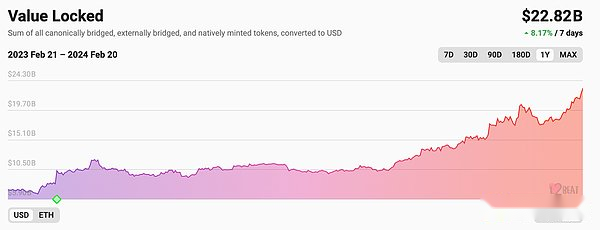
Source:https://l2beat.com/scaling/summary
When solving the complicated challenge of MEV, Rollup faces the subtle balance between maintaining user protection and profit.This challenge involves how to prevent harmful MEV behaviors such as front transactions and sandwich attacks, while effectively using block space to achieve benefits.Although traditionally Rollup relies on a single operator model and adopts an advanced first -out (FIFO) order to protect users from MEV.Important role.At the same time, to ensure that the principle of FIFO and maintaining the transparency of block sorting also brings additional operating challenges.In addition, using the underlying block space as the source of income, although it is beneficial, it has also triggered the user’s trust. They must trust the operator to use this space and other means to use this space to damage their interests, which may erode.The integrity of the transaction and the trust of the user.
The shared sorter provides an innovative solution for handling the MEV problem. By introducing a more secure and fair trading sorting mechanism in the blockchain network, especially for the second -layer solution for Ethereum, such as RollUp, it brings significantlybenefit.It effectively balances the needs and interests of network participants by dividing the block space of Rollup as the top block space that protects user transactions and allows builders to use MEV’s bottom block space.Using practical can be delayed encryption (PVDE) technology, sharing sorters ensure that user transactions are not visible to malicious actors, thereby preventing harmful MEV practices such as pre -transactions and sandwiches attacks.In addition, by allowing MEV activities to perform beneficial MEV activities at the bottom of the bottom, share the income for ROLLUP, while maintaining the integrity of the network and user trust.This mechanism not only improves the security and fairness of the transaction, but also provides support for the sustainable development of the blockchain network through innovative income generation methods.In short, through its unique processing method of MEV, the shared sorter brings positive changes to the blockchain ecosystem, and realizes the balance between protecting the interests of users and promoting the healthy development of the network.
In general, the problem of centralized sorters still comes from the sorter power and risk exposure of the sorter composed of a single node. The decentralized sorter consisting of multiple nodes can solve the centralized sorter.question.The decentralized sorter can ensure the stability and effectiveness of L2 sorting while bringing some additional benefits.For example, the decentralized sorter represented by Metis can further empower the tokens while achieving the income dividend. Share sorters make the L2 no need to build a sorting network. At the same timeOperating.In the long run, the wave of modularity and L2 will promote the decentralization of the sorter, and there is still huge market space in the decentralized sorter market.
>
Source:>https://joncharbonneau.substack.com/p/rollups-alnt- real
Decentralized sorter project
Metis
Elena Sinelnikova, the co -founder and CEO of Metis, has been committed to the education and evangelism of the blockchain industry before. It is the co -founder of the educational non -profit organization Cryptochicks. Cryptochicks is currently the largest female blockchain community in the world.56 countries.Kevin Li is the co -founder and product leader of Metis. The co -founder and CEO of ZKM. At the same time, Kevin is also an active researcher at the tokens economy, DAO, DEFI, and blockchain governance.
Metis is the first to propose and test the Ethereum L2 of the decentralized sorter.
Metis changed the original single sorter node to a sorter pool composed of many nodes, and to achieve decentralization of the sorter through a random rotation mechanism.
First, there will be an admin character in Metis’s decentralized sorter network.Admin’s accusation is to manage the decentralized sorter system, including adding the required sorter node to the SEQUENCER LIST whitelist, setting the pledge limit of a single node, the release speed of the block reward, and so on.
Subsequently, Metis introduced the node pledge mechanism.Any node pledged 2W Metis tokens can become one of the nodes of the sorter pool.The nodes in the sorter pool have the right to see the content in the trading pool, and the selected sorter node has the right to pack the transaction.
Secondly, Metis introduced POS node rotation mechanisms.The pledge amount of each node will be randomly selected to be randomly selected with the number of hash numbers.The selected sorter node can be packed in block transactions.
Immediately afterwards, the packaged trading BATCH required at least 2/3 of the signs to sign, and the Batch was considered valid and submitted to L1.The key to sorter node signature is managed by Metis’s POS consensus layer. The consensus layer will generate multiple signing keys when the sorter node is added or exited the network.
Finally, in order to prevent the sorter from doing evil, Metis also introduces the role of the verified as a random sampling of the block, check whether the transaction order in the block is correct, and so on.Nodes that are maliciously be punished by pledge funds are punished.
>
Source:https://www.metis.io/decentralized- sequencer
Based on the above process, Metis can build a set of decentralized sorter architecture based on POS network consensus.The pledge of 2W Metis can become a sorter node, making the sorter node more diverse, avoiding single -point faults, single -point control and malicious MEV extraction of sorter nodes.The node rotation mechanism and the multiple -sign confirmation make the selection of the sorter node more fair, and at the same time, it can also avoid the sorter node to do evil to a certain extent.The authenticated sampling inspection and punishment can also further reduce the risks brought by the malicious behavior of nodes.
In order to further inspire more nodes to participate in the decentralized sorter network of Metis, Metis also introduced additional incentive mechanisms.After the sorter node is successfully out of the block, it can not only get the GAS income of the original sorter, but also get additional Metis token emission rewards.Metis’s incentive mechanism may produce a positive growth flywheel.The prosperity of Metis network transaction activities will drive the income of sorter node income.Increased income income of sorter nodes will attract more users to pledge Metis, become sorter nodes, and capture sorter income.The reduction of Metis in circulation and the increase in Metis demand generated by pledge will further increase the market price of Metis.The increase in Metis prices will increase the asset value of the pledged node, and the pledge reward appreciates, thereby generating greater attractiveness to the node, attracting more node pledge, and forming a closed loop of the flywheel.
Metis’s POS decentralized sorter network is the first attempt for L2 to achieve decentralized sorters.The landing of Metis decentralized sorters is expected to drive other L2 to promote the decentralized plan of its sorter.
Espresso Systems
ESPRESSO’s team background is very luxurious. The co -founder Charles Lu and Ben Fisch are Ph.D. in computer science at Stanford University. Team members have also worked in Web2 and Web3 -headed companies in Binance Labs, Coinbase, Google, etc.Previously, Espresso also successfully received US $ 23 million in top ventilation institutions such as Sequoia Capital, Coinbase Ventures, Polychain, Robot Ventures.
ESPRESSO is positioned as a middleware between L1 and L2, which will be decoupled by sorting and executing. It aims to be a decentralized shared sorter network and provide decentralized sorter services for different L2.Similar to the DA outsourcing in the concept of modularization, the services provided by Espresso are more like transaction data sorting outsourcing services.Like the DA outsourcing, the sorting outsourcing services provided by Espresso are not related to chain and virtual machines. Any type of L2 can use Espresso’s sorting service.
>
Source:>https://hackmd.io/@espressOsystems/espressosequency
Espresso’s core idea is to provide a modular sorter middleware for L2.After the user sends transaction data through the client, the transaction data will be sent to the sorter network of Espresso by the L2 identifier of the L2.Broadcast to subscriber (L2 node).Subsequently, L2 was executed based on the sequential transaction data that has been packaged.At the same time, ESPRESSO will also submit a block commitment containing the transaction to L1 sorter contract.Finally, L2 needs to send a new state to L1. The Rollup contract of L1 uses block promises from Espresso to verify the status update submitted by L2 to ensure the correctness of execution.
 Source:https://docs.eSpressosys.com/sequence/espresso- sequeencer-rachitecture/system-OverView
Source:https://docs.eSpressosys.com/sequence/espresso- sequeencer-rachitecture/system-OverView
In the future, Espresso also intends to participate in sorting through Eigenlayer’s existing verification nodes in Ethereum to achieve higher security.
In general, Espresso’s decentralized sorter solution is more fitted with the concept of modular blockchain. Through the form of sorting outsourcing, it uses its own POS network to achieve decentralized sorting, which constitutes L1 and L2The intermediate parts of the decentralized sorter network.ESPRESSO’s universal sorting service makes it a shared sorter network. Any L2 can use Espresso sorter services.Furthermore, L2, using Espresso as a sorter service provider together, can even enjoy more seamless interoperability.
ASTRIA
Astria’s CEO Josh Bowen is the biggest promoter of the project.JOSH BOWEN has worked for the startup Edge & Amp; Node and Celestia Labs behind the startup.The past work resume allows him to have a deeper understanding of the concepts of modularization and decentralization.He has repeatedly shared important insights on sharing sorters in maintaining the speed and decentralization of the blockchain.Bowen emphasizes that most of the Rollup -specific Rollup may not need its own sorter to cultivate a more decentralized and modular shared sorter network, which is conducive to building a more decentralized and efficient blockchain system.The concepts of JOSH BOWEN and Astria also received support from institutions such as Maven 11, 1KX, Delphi Ventures, and Figment Capital, and raised $ 5.5 million seed round financing.
Similar to Espresso, Astria also aims to provide a decentralized shared sorter network.Astria’s shared sorter network is a middleware blockchain with its own decentralized sorter set and can accept transaction data from multiple L2.Similarly, ASTRIA can also process any type of L2 sort request.Further, the L2 of Astria can also enjoy the atomic interoperability provided by Astria.
The sorting process of ASTRIA is shown in the figure below.
ASTRIA’s decentralized sorter network is very similar to the solution of Espresso. Both are committed to providing an decoupled decentralized sorting service for any L2.L2 can further simplify the development process and operating costs of L2 through outsourcing sorting services, and enjoy the combination of atomic L2.
Radius
Radius focuses on the development of trustworthiness and shared sorting layers to solve the challenges of the harmful MEV extraction and review system in the blockchain field.RADIUS has successfully succeeded from Hashed, SuperScrypt, Lambdaclass (Ericodic Fund) and and and and.Crypto.comInvestment institutions have received $ 1.7 million Pre-SEED round financing.
Radius also aims to build a shared sorter network without trust and anti -review, and compared to Espresso and Astria, Radius’s biggest feature is that it can effectively reduce harmful MEVs through encrypted memory pools.
The overall architecture of Radius shared sorter network is similar to the mainstream shared sorter network.The user submits encrypted transaction data and proofs to the sorter layer via Dapps.The sorter verifies the transaction data and proofs provided by the user and packs them.Subsequently, Rollup received a sequential block from the sorter network, executed the transaction in order, and submitted the status and status of the execution to the settlement layer.
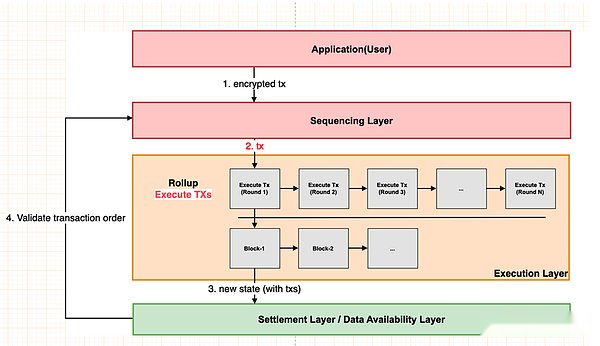 Source:>https://docs.Theradius.xyz/developer/architecture
Source:>https://docs.Theradius.xyz/developer/architecture
Interestingly, Radius introduces encrypted memory pools to prevent the sorter from extracting harmful MEVs.The transaction submitted by the user will be encrypted and submitted to the sorter network in the form of encrypted data.The sorter cannot obtain the key when sorting the transaction, and cannot decrypt the specific content of each transaction.Therefore, the sorter cannot extract MEV through malicious sorting and inserting transactions.
Radius divides block space into top space and bottom space.The top space is dedicated to user transactions, which effectively avoids harmful MEVs by encrypted memory pools.The bottom space introduces a auction -based open market. In the transaction, it can create a benign MEV bundling transaction of cross Rollup, such as benign arbitrage, liquidation, and so on.Subsequently, the trader submitted the bundled transaction and the price to the sorter, and the sorter selected the highest binding transaction, which included it in the block to maximize the RollUp profit and cultivate a benign MEV competitive market.
Compared with Espresso and Astria, Radius has two significant advantages.First, by introducing encrypted memory pools and dividing block space into top space and bottom space, Radius can effectively eliminate harmful MEV transactions, cultivate a benign MEV competitive market, and maximize Rollup’s profits.Second, the introduction of encrypted memory pools makes it impossible for a single sorter node to be evil through MEV. Therefore, there is no need to introduce an additional consensus mechanism to ensure the correctness of the sorting, which can greatly improve the final confirmation speed and expansion of the sorter network.
Suave (Single Unifying Auction for Value Expression)
The Suave solution is proposed by the Flashbots team. Flashbots is a pioneer team dedicated to solving the MEV problem in the Ethereum ecosystem. It is composed of a group of professionals with deep background in computer science, mathematics, psychology and economics.According to the information of the Lingying, the team currently includes 28 employees, and their professional skills cover a wide range of fields such as Python programming, blockchain technology, machine learning to C language.
Flashbots’ founding teams include Philip Daiian and Stephane Gosselin, who resigned from the team in October 2022 with the team’s divergence in the censorship system.In addition, Alex Obadia, another co -founder and top strategic researcher, left Flashbots for personal reasons in June 2023.The core members include Andrew Miller. He is well known for cracking the research of Intel’s SGX code. He is currently a research director of the trusted execution environment and Suave.Miller plans to take a temporary vacation from the assistant professor of the University of Illinois. His work in the academic world focuses on electrical and computer engineering.Another core member HASU, a strategic director of Flashbots, has a wide range of influence in the blockchain field, including strategic consultants of Lido as a liquidity pledged agreement and research collaborators of Paradigm Investment Company.Hasu is committed to promoting the development and education of the industry by writing, social media and podcasts.
Suave is a unique decentralized builder and sorter, which is obviously different from the design of other shared or sorting layers.It aims to provide transaction sorting services for Ethereum and other blockchains, but it is not directly embedded in the agreement of any chain.Users can send transactions to Suave’s encrypted memory pool, while Suave’s executor network is responsible for output blocks or parts of the chain.These blocks will compete with traditional centralized Ethereum builders, and they will be selected by Ethereum proposals.
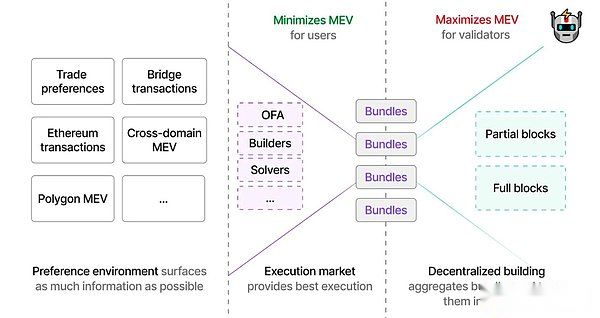 Source:https://foreSightnews.pro/article/detail/28930
Source:https://foreSightnews.pro/article/detail/28930
Suave does not replace the mechanism of the Rollup selection of the block, nor will it change the bifurcation rules of the chain.It focuses on providing the ranking of the optimal profit for any chain, and usually has a complete state to simulate the results of different transactions and create the best sorting.This design allows Suave to collaborate with shared sorters or other MEV-Aware builders to provide services such as atomic cross-chain arbitrage to ensure that several transactions are executed or canceled at the same time.
 Source:https://foreSightnews.pro/article/detail/28930
Source:https://foreSightnews.pro/article/detail/28930
In the long run, Rollup may be a better choice.Rollup guarantees its security, anti -review and activity through L1, and Suave, as a chain focusing on trading sorting, is not suitable for ordinary users. The goal is to limit the needs of users to receive Suave by the user./Builder provides an operating platform.Suave focuses on providing the most favorable sorting for transactions, rather than completely replacing the existing sorting mechanism.It can handle complete transactions to create the best transaction sorting.
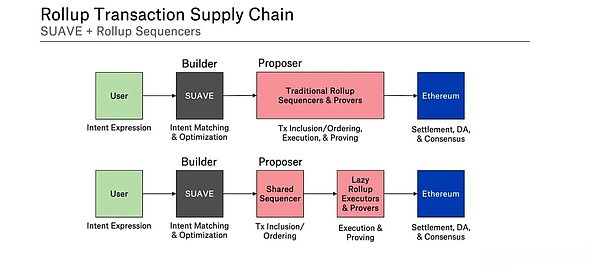 Source:https://foreSightnews.pro/article/detail/28930
Source:https://foreSightnews.pro/article/detail/28930
Regarding the processing of MEV, there are multiple mechanisms to reduce the sorting of transactions and contains related potential competition and negative externalities.For example, the FBA-FCFS model proposed by the ARBITRUM time improvement mechanism and Flashbots are trying to reduce the motivation to delay competition by allowing users to express their preferences for fast included transactions by allowing users to express their preferences.
ARBITRUM’s time improvement mechanism
The time improvement mechanism is a security measure to prevent a specific type of attack, called the “time bandit attack”.In such an attack, an attacker may try to re -organize the confirmed blocks to use some unknown information (for example, using the knowledge of a certain transaction afterwards) to profit.
ARBITRUM defends this attack through a unique mechanism. It allows anyone to submit a “challenge” when discovering that someone tries to perform time robber attacks to prove an attacker’s behavior.This mechanism is based on an economic incentive to ensure that the potential interests of the attackers are offset, thereby protecting the security and fairness of the network.
Flashbots’ FBA-FCFS model
FBA -FCFS (First Bid Auction -First Come, First Served) model is a trading sorting mechanism proposed by Flashbots.The purpose of this model is to solve the problem of traditional transaction selection and sorting, especially in the MEV extraction environment.
The FBA-FCFS model is trying to balance fairness and efficiency, optimize the use of network resources by allowing bids to be allowed, and ensure that some users will not be completely excluded due to insufficient payment ability.
These mechanisms have their own advantages and disadvantages, but the common goal is to improve the efficiency and fairness of transaction processing.
By cooperating with Rollup and other MEV-AWARE builders, Suave aims to provide higher economic security and efficiency for cross-chain operations, while exploring new economic security models and MEV slowing mechanisms, improving blockchain transaction sorting and executionDecentralization.
Summary and outlook
Although Metis, ASTRIA, ESPRESSO, Radius, and Suave, these projects have their own emphasis, but they pay attention to improving the scalability and transaction efficiency of the blockchain.
Through its Layer 2 solution, Metis focuses on optimizing the transaction processing capabilities of Ethereum to reduce costs and improve efficiency. It aims to provide developers and enterprises with a more convenient development platform.ASTRIA and Espresso proposed the concept of decentralized shared sorter network, supporting the transaction data processing of multiple Layer 2 solutions, which not only simplifies the development and operation process, but also strengthens the combined and interoperability between systems and mutual operations.sex.The RADIUS project is divided by the introduction of encrypted memory pools and block space, and is committed to creating a network without trust and anti -review, which aims to reduce the harmful effects of MEV and improve the privacy and security of transactions.Suave focuses on solving the impact of MEV on the fairness and transparency of transactions through the decentralized sorter network, showing a commitment to improving the fairness of the transaction environment.
When exploring the development direction of decentralized sorters, Metis and Espresso provide two very different modes, namely the “self -operated store” model and the “outsourcing module” method.These two models each reflect the different thinking and strategies of the community in building and maintaining decentralized sorters.
The “self -operated store” model adopted by Metis emphasizes that through internal management and operation of its decentralized sorter network to ensure the security and stability of the network.This method allows Metis to directly control nodes in its network and maintain a healthy network environment by pledge and incentive mechanism.Although this model can improve the security and reliability of the network, it also requires Metis to bear greater operating responsibilities and resource investment, which may limit the flexibility and scalability of the network to a certain extent.
In contrast, the “outsourcing module” method adopted by Espresso provides a more flexible and open solution.By allowing any blockchain project to access its sorting services, ESPRESSO has promoted the technology of technology, and also reduces the operating burden of a single project.The challenge of this model is that it may introduce additional trust issues, because the project party needs to depend on ESPRESSO to deal with transactions in a fair and safe manner.In addition, any issues or attacks on ESPRESSO services may have an impact on widespread customer projects.
Metis’s “self -operated store” model and ESPRESSO’s “outsourcing module” method shows two main development paths in the field of decentralized sorters.Each mode has its unique advantages and challenges facing, and which one to choose depends on the specific needs of the project, the status of resources, and the degree of importance to decentralization and security.
The development prospects of decentralized sorters indicate the huge potential of blockchain technology in improving network security, enhancing anti -review capabilities, improving transaction efficiency, reducing costs, and promoting the diversity of ecosystem diversity and interoperability.With the continuous advancement of decentralized sorter technology, we can foresee a more secure and efficient blockchain network. Among them, the decentralized sorting mechanism can effectively defend the single -point failure and malicious attacks, protect the security of user assets and data.EssenceIn addition, the optimization and innovation of decentralized sorters, such as batch processing and status channels, will further improve the transaction processing capacity of the L2 platform, reduce user transaction costs, and achieve high throughput and low delay transactions, so as not to sacrifice without sacrificingImprove user experience on the basis of security and decentralization.
At the same time, the popularity of decentralized sorters is expected to promote the formation of a more diverse and interoperable blockchain ecosystem.Share sorter networks, such as Espresso and Astria, will not only provide services for multiple L2 platforms, but also promote the flow of data and assets between different platforms, and create a more open and Unicom decentralized world.In addition, the incentive mechanism and the innovation of token economic models will provide reasonable incentives for the participants of the decentralized sorter network. At the same time, the network governance and income distribution through the token economic model will attract more participants and stimulate the vitality of the community.
Although the outlook for decentralized sorters is bright, they still face challenges in terms of technical realization, network performance optimization, and governance model design.Therefore, the future development direction may focus on studying more efficient consensus mechanisms, exploring scalable network architectures, and developing user -friendly interfaces and tools to meet the growth of market demand and user expectations.In short, decentralized sorters are one of the key factors to promote the development of blockchain technology and application. Its future evolution will play a vital role in building a more efficient, safe, and open decentralized world.

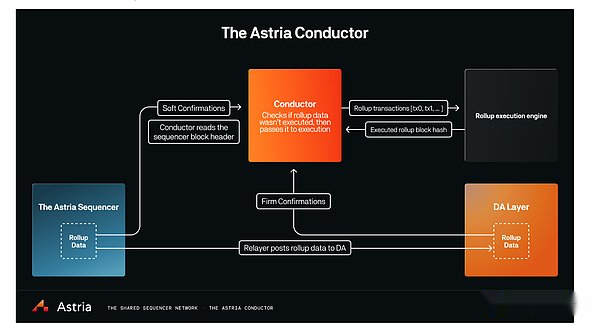 Source:
Source: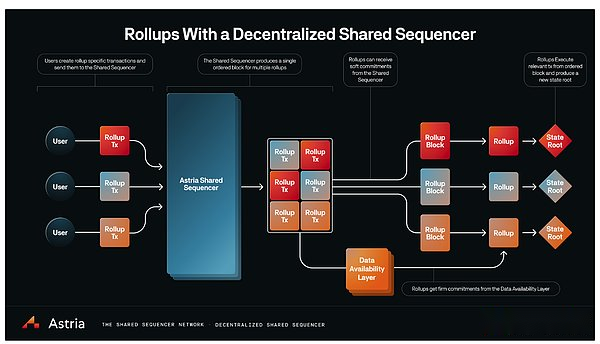 Source:
Source: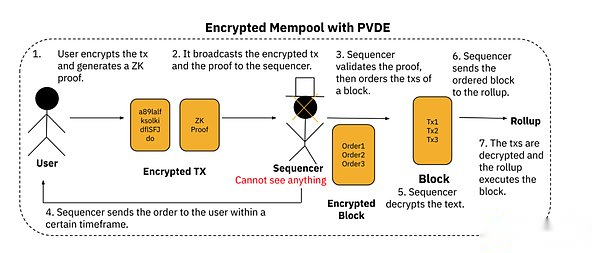 Source:
Source:






